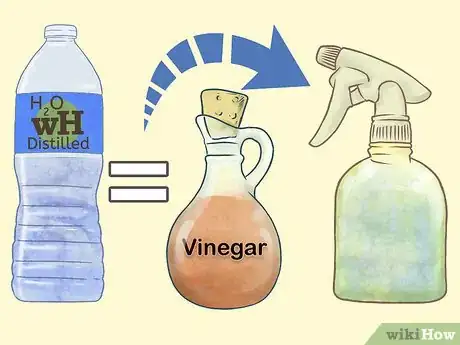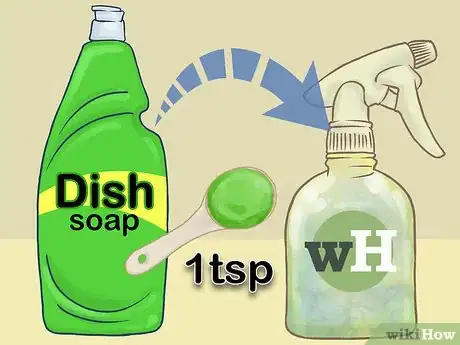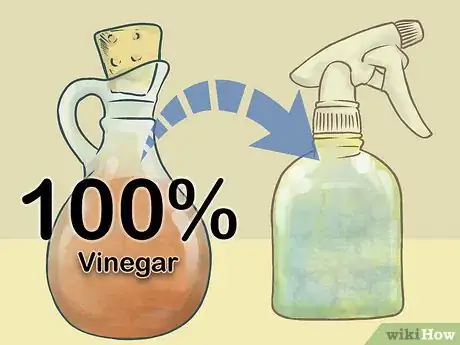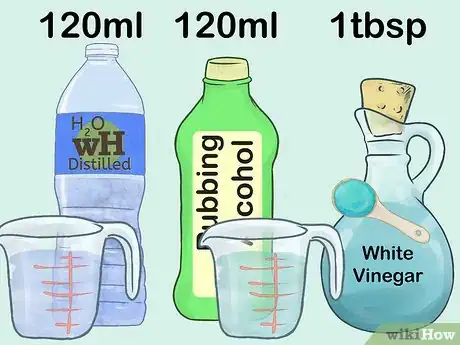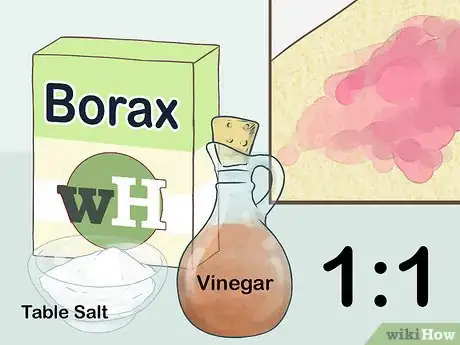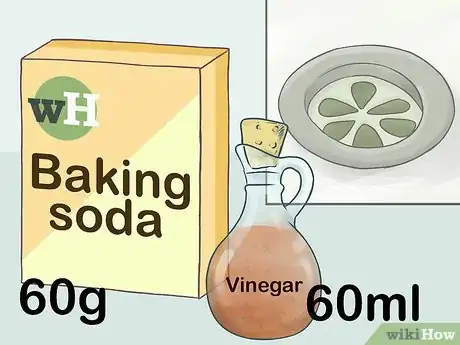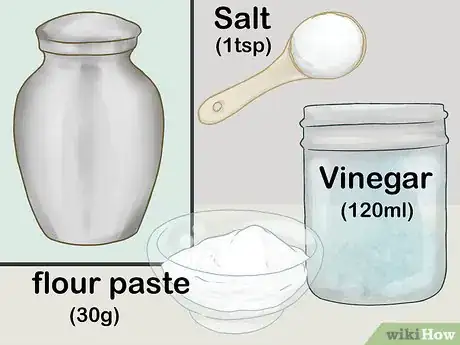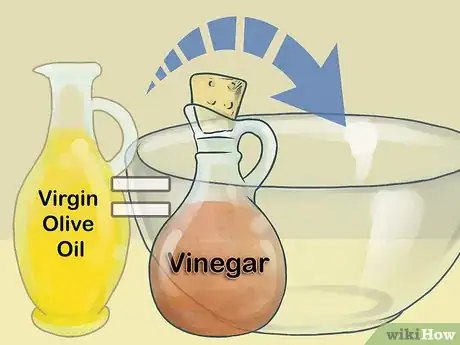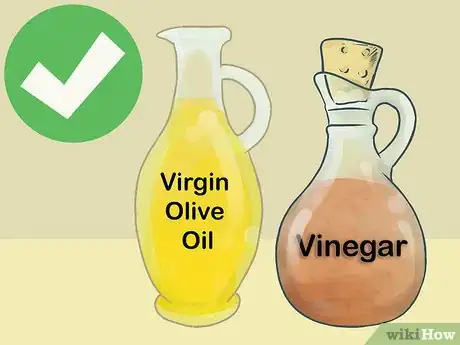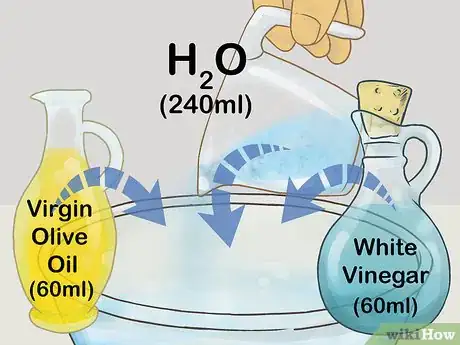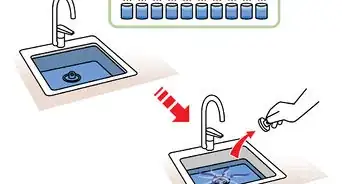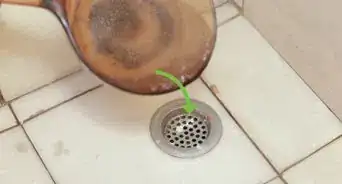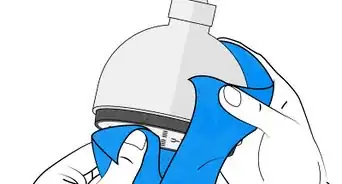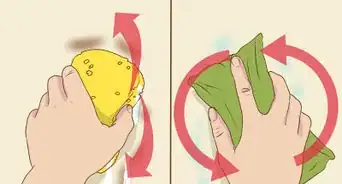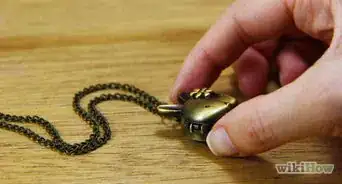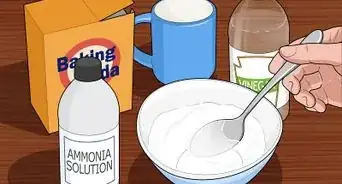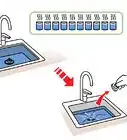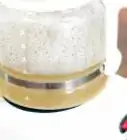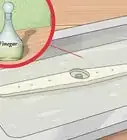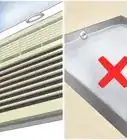This article was co-authored by Susan Stocker and by wikiHow staff writer, Amber Crain. Susan Stocker runs and owns Susan’s Green Cleaning, the #1 Green Cleaning Company in Seattle. She is well known in the region for outstanding customer service protocols — winning the 2017 Better Business Torch Award for Ethics & Integrity —and her energetic support of green cleaning practices.
wikiHow marks an article as reader-approved once it receives enough positive feedback. In this case, 96% of readers who voted found the article helpful, earning it our reader-approved status.
This article has been viewed 579,305 times.
Many people want to avoid the toxic and abrasive chemicals in commercially made cleaning products. Distilled white vinegar, whether used alone or in a variety of natural mixtures, can effectively replace almost every chemical cleaner in your household. Mix up liquid solutions to clean smooth surfaces, like countertops, appliances, glass and tile. Create pastes and scrubs when you need something a little more abrasive. You can even create furniture and metal polishes using vinegar solutions.
Steps
Making Liquid Cleaners
-
1Mix equal parts water and vinegar in a spray bottle. Use distilled white vinegar and, if possible, distilled or filtered water.[1] If you don’t have those on hand, tap water will work fine. Put them in an empty spray bottle, attach the nozzle and shake briefly to combine them.
- Spray this mixture on kitchen and bathroom countertops, stovetops, backsplashes, toilet surfaces, tile, flooring and almost any smooth surface you wish. Wipe it up with a paper towel or sponge.
- Vinegar and water solutions can help eliminate dirt, soap scum, sticky spills and hard water.
EXPERT TIPJames Sears leads the customer happiness team at Neatly, a group of cleaning gurus based in Los Angeles and Orange County, California. James and the team have nine years of experience and offer green cleaning, interior and exterior window washing, and general apartment cleaning services. He provides transformative cleaning experiences by reducing clutter and renewing your home environment. James is a Trustee Scholar at the University of Southern California.House Cleaning Professional
 James Sears
James Sears
House Cleaning ProfessionalMake a simple cleaning spray with 3 parts water and 1 part distilled vinegar. You can dilute the mixture according to your needs and you can also trade out the distilled white vinegar for apple cider vinegar.
-
2Add lemon juice to disinfect surfaces. Mix one part lemon juice, one part white vinegar and two parts water in a spray bottle. Replace the nozzle and give it a shake. Spray the solution on smooth surfaces you want to disinfect, such as in the kitchen or bathroom. This mixture can typically eliminate 99% of bacteria from surfaces, making it ideal for sanitization.
- Lemon tends to cut the odor of the vinegar. Fill a quart-sized glass jar with lemon rinds. Cover with white vinegar. Let it sit for 2 weeks. Strain the lemon rinds out using a cheesecloth or strainer into a glass spray bottle.
Advertisement -
3Add dish soap for persistent stains on carpet. If the vinegar and water solution isn’t getting rid of a carpet stain, add a teaspoon of mild dish soap to the spray bottle. Give it a shake, then spray it directly onto the stain. Allow it to soak for about two minutes, then gently blot at the spill with a clean towel or sponge.
-
4Tackle tough stains and grime with undiluted vinegar. To clean heavy soap scum and mineral deposits, skip the water and pour white distilled vinegar into a spray bottle, straight from the jug. Replace the nozzle. Spray the solution onto the affected area, scrub with a brush or sponge and rinse with water.
- Use undiluted solutions for soap scum on shower walls and hard water deposits. For toilets, pour straight vinegar right into the bowl.
- Try disinfecting cutting boards with undiluted vinegar.
- Do not use it on marble or stone counters or floors or it will etch them permanently.
-
5Put vinegar and water in a bowl to clean microwaves and ovens. Mix equal parts white vinegar and water, then pour them into a heat-safe bowl. Place the bowl in your microwave or conventional oven. Microwave or heat the solution long enough to bring it to a boil. Let it cool down a bit before you open the door.
- Odors will be eliminated and splattered food will be loosened and easy to wipe away.
-
6Mix vinegar, rubbing alcohol and water to create a glass cleaner. Measure out 1 cup (240 mL) of rubbing alcohol, 1 cup (240 mL) of water and 1 tablespoon of white vinegar. Pour them into a spray bottle. Spray the mixture onto glass, mirrors, ceramic tiles and chrome finishes, then wipe with a paper towel or microfiber cloth.
- This mixture is effective for cleaning and polishing glass surfaces.
- For a pleasant citrus scent, add one or two drops of orange essential oil to the mixture.[2]
Creating Vinegar Scrubs and Pastes
-
1Use equal parts vinegar, salt and Borax to remove carpet stains. For tough carpet or fabric stains, mix equal parts vinegar, table salt and Borax in a large bowl until a paste forms. Apply the paste directly to the stained area. Allow the paste to sit for several minutes before wiping it up with a clean towel. Rinse the area with water.
-
2Unclog a drain with baking soda and vinegar. Baking soda is a mild abrasive. Combined with vinegar’s acidic properties, the duo can effectively unclog kitchen drains. Pour ½ cup (125 g) of baking soda down the drain. Follow it up with a ½ cup (120 mL) of white vinegar. The combination of the two will create fizz. Once it stops fizzing, pour warm or hot water down the drain.EXPERT TIPKadi Dulude is a House Cleaning Professional and the Owner of Wizard of Homes, a New York City-based cleaning company. Kadi has over 10 years of experience and manages a team of over 90 registered cleaning professionals. Her cleaning advice has been featured in Architectural Digest and New York Magazine.House Cleaning Professional

 Kadi Dulude
Kadi Dulude
House Cleaning ProfessionalOur Expert Agrees: Pour several spoonfuls of baking soda into your drain and add a cup of vinegar. Let the mixture sit and fizz up for five minutes, then rinse with hot water. The combination can remove small clogs in the drain and deodorize the sink.
-
3Clean brass with a table salt and vinegar scrub. Immerse a sponge in white vinegar, then wring out the excess liquid. Sprinkle table salt evenly over one side of the sponge. Gently scrub brass surfaces with the mixture. Rinse the area thoroughly with clean water, then dry it with a soft towel.[3]
-
4Clean metal surfaces with a vinegar, salt and flour paste. Use this paste on silver, pewter, copper, or brass. Combine 1 teaspoon salt with 1 cup (240 mL) of vinegar. Add ¼ cup (30 g) of flour and stir until a paste forms. Apply the paste to the metal surface and let it sit for about 15 minutes. Rinse it off with warm water and then polish the surface with a clean cloth.
Polishing Surfaces with Vinegar and Oil
-
1Mix equal parts vinegar and olive oil to make a furniture polish. Measure out equal parts of white vinegar and olive oil, then mix them together in a large bowl or jar. Test the mixture out on an inconspicuous area of your wooden furniture before applying it onto the entire surface. If there is no negative reaction, dampen a soft cloth with the mixture and rub it on the surface. Polish the wooden surface by rubbing in slow, circular motions.
- Use a clean, dry cloth to remove any excess from the surface.
- This mixture works well on wooden furniture such as coffee tables, desks and dressers. It can effectively remove rings left behind by beverage glasses.
-
2Remove smudges from stainless steel with vinegar and olive oil. Apply 1 tablespoon of olive oil to one side of a cloth or sponge. Rub it on the surface of stainless steel to remove smudges. Dampen the other side of the sponge with white vinegar. Use it to wipe away the olive oil and polish the steel surface.[4]
-
3Use olive oil, vinegar and water to clean and polish wood paneling. Mix 2 cups (480 mL) of warm water with ½ cup (120 mL) of white vinegar and ½ cup (120 mL) of olive oil. Apply the mixture to wood paneling with a clean, soft cloth. Rub it gently over the surface. Use a clean, dry cloth to wipe it away, simultaneously cleaning and polishing the wood paneled surface.[5]
Expert Q&A
-
QuestionWhat kills the smell of vinegar?
 Susan StockerSusan Stocker runs and owns Susan’s Green Cleaning, the #1 Green Cleaning Company in Seattle. She is well known in the region for outstanding customer service protocols — winning the 2017 Better Business Torch Award for Ethics & Integrity —and her energetic support of green cleaning practices.
Susan StockerSusan Stocker runs and owns Susan’s Green Cleaning, the #1 Green Cleaning Company in Seattle. She is well known in the region for outstanding customer service protocols — winning the 2017 Better Business Torch Award for Ethics & Integrity —and her energetic support of green cleaning practices.
Green Cleaning Expert I'd recommend putting a glass full of coffee grounds on a counter to absorb the smell. The best way is to stop the smell before you use it, though. You can do this by cutting the smell with some lemon or orange added to the vinegar.
I'd recommend putting a glass full of coffee grounds on a counter to absorb the smell. The best way is to stop the smell before you use it, though. You can do this by cutting the smell with some lemon or orange added to the vinegar. -
QuestionHow do you make a cleaning solution with baking soda?
 Susan StockerSusan Stocker runs and owns Susan’s Green Cleaning, the #1 Green Cleaning Company in Seattle. She is well known in the region for outstanding customer service protocols — winning the 2017 Better Business Torch Award for Ethics & Integrity —and her energetic support of green cleaning practices.
Susan StockerSusan Stocker runs and owns Susan’s Green Cleaning, the #1 Green Cleaning Company in Seattle. She is well known in the region for outstanding customer service protocols — winning the 2017 Better Business Torch Award for Ethics & Integrity —and her energetic support of green cleaning practices.
Green Cleaning Expert I don't really recommend this mix as a cleaning solution. Since vinegar is acidic and baking soda is basic, if you mix them, you'll get water and sodium acetate, which can explode when stored in a bottle. Mixing the two also releases carbon dioxide gas, which can be harmful to you.
I don't really recommend this mix as a cleaning solution. Since vinegar is acidic and baking soda is basic, if you mix them, you'll get water and sodium acetate, which can explode when stored in a bottle. Mixing the two also releases carbon dioxide gas, which can be harmful to you. -
QuestionWhat is the ratio of vinegar to water for cleaning?
 Kadi DuludeKadi Dulude is a House Cleaning Professional and the Owner of Wizard of Homes, a New York City-based cleaning company. Kadi has over 10 years of experience and manages a team of over 90 registered cleaning professionals. Her cleaning advice has been featured in Architectural Digest and New York Magazine.
Kadi DuludeKadi Dulude is a House Cleaning Professional and the Owner of Wizard of Homes, a New York City-based cleaning company. Kadi has over 10 years of experience and manages a team of over 90 registered cleaning professionals. Her cleaning advice has been featured in Architectural Digest and New York Magazine.
House Cleaning Professional To clean floors or other surfaces, you can use 50/50 vinegar and water solution.
To clean floors or other surfaces, you can use 50/50 vinegar and water solution.
References
- ↑ http://www.goodgirlgonegreen.com/7-diy-cleaning-recipes-using-vinegar/
- ↑ http://www.goodhousekeeping.com/home/cleaning/tips/a24885/make-at-home-cleaners/
- ↑ http://www.goodhousekeeping.com/home/cleaning/tips/a24885/make-at-home-cleaners/
- ↑ http://www.goodgirlgonegreen.com/7-diy-cleaning-recipes-using-vinegar/
- ↑ http://www.goodgirlgonegreen.com/7-diy-cleaning-recipes-using-vinegar/
About This Article
The acidity in vinegar makes it a great non-toxic cleaner that can be used all around your home. You can use straight vinegar to clean toilet bowls, chrome surfaces, and your showerhead and door. Use equal parts vinegar and water to clean faucets, windows, your refrigerator, countertops, and most other hard surfaces. Just spray or pour the solution onto the surface you’re cleaning, then wipe it up with a warm, damp cloth. To clean your floors with vinegar, make a weaker solution by mixing ½ cup (120 mL) of vinegar with 1 gallon (3.8 L) of water. Then, dip a mop in the mixture and mop your floors with it. Let the floors air dry when you’re finished. You can also make a vinegar cleaning paste for things like carpet stains, grill grates, and tile surfaces. Just mix equal parts baking soda and vinegar, then apply it to the surface you’re cleaning. While it fizzes, use a sponge or brush to scrub the surface clean. Rinse with clean water when you’re finished. Whichever type of solution you make, avoid applying it to natural stone or wood since vinegar can damage these surfaces. If you want to learn how to make a vinegar scrub or paste for cleaning, keep reading the article!
